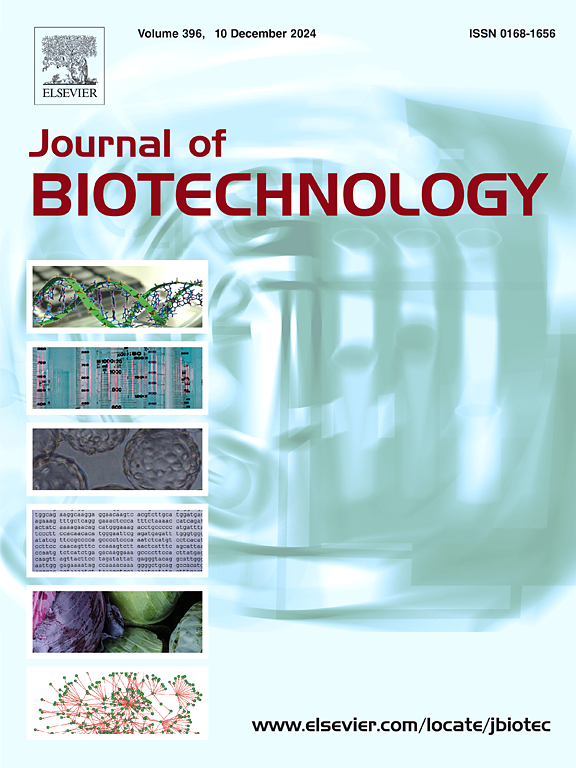无质粒谷氨酸棒状杆菌利用木质纤维素原料衍生糖高效生产γ-氨基丁酸(GABA)的逐步代谢工程
IF 3.9
2区 生物学
Q2 BIOTECHNOLOGY & APPLIED MICROBIOLOGY
引用次数: 0
摘要
γ-氨基丁酸(GABA)是产l -谷氨酸棒状杆菌谷氨酸脱羧酶在质粒上表达的产物。然而,在发酵过程中添加抗生素来维持表达质粒,不仅增加了生产和回收成本,而且存在潜在的食品安全隐患。本研究以谷氨酸C. glutamicum GJ04为底盘,构建了无质粒产生GABA的谷氨酸C. glutamum菌株,利用木质纤维素来源的葡萄糖和木糖共同产生l -谷氨酸。通过替换ldh、gabT、gabD基因,将分泌型谷氨酸脱羧酶(secretglutamate decarboxylase) 3拷贝整合到谷氨酸c.g amicum GJ04基因组中。通过敲除aceA和gabP基因,进一步微调工程C. glutamum的代谢通量,以增强GABA的产生。重组菌株C. glutamicum GJ09可从15 % (w/w)固体含量的玉米芯残渣水解产物中获得44.3 ± 3.8 g/L GABA,产率和生产率分别为0.45 g/g和0.74 g/L/h。玉米芯渣糖浆料分批发酵的GABA滴度最高可达63.4 g/L。本研究通过逐步代谢工程为木质纤维素原料工业化生产氨基丁酸提供了一株健壮且无质粒的谷氨酸丙氨酸菌株。本文章由计算机程序翻译,如有差异,请以英文原文为准。
Stepwise metabolic engineering of a plasmid-free Corynebacterium glutamicum for efficient production of γ-aminobutyric acid (GABA) by co-utilizing lignocellulosic feedstock-derived sugars
γ-aminobutyric acid (GABA) can be synthesized through plasmid-based expression of glutamate decarboxylase in L-glutamic acid producing Corynebacterium glutamicum strain. However, the addition of antibiotic to maintain the expression plasmid during the fermentation not only increases production and recovery costs, but also poses potential food safety hazards. In this study, a plasmid-free GABA producing C. glutamicum strain was constructed from C. glutamicum GJ04 chassis, which can produce L-glutamate by co-utilizing lignocellulose-derived glucose and xylose. Secretory glutamate decarboxylase was integrated into the genome of C. glutamicum GJ04 in three copies by replacing ldh, gabT, gabD genes. The metabolic flux in engineered C. glutamicum was further fine-tuned by knocking out aceA and gabP genes to enhance GABA production. The recombinant strain C. glutamicum GJ09 can produce 44.3 ± 3.8 g/L GABA from 15 % (w/w) solids loading corncob residues hydrolysate with the yield and productivity of 0.45 g/g and 0.74 g/L/h. The highest GABA titer reached 63.4 g/L by fed-batch fermentation using corncob residues-derived syrup. This study provided a robust and plasmid-free C. glutamicum strain by stepwise metabolic engineering for industrial production of GABA from lignocellulosic feedstocks.
求助全文
通过发布文献求助,成功后即可免费获取论文全文。
去求助
来源期刊

Journal of biotechnology
工程技术-生物工程与应用微生物
CiteScore
8.90
自引率
2.40%
发文量
190
审稿时长
45 days
期刊介绍:
The Journal of Biotechnology has an open access mirror journal, the Journal of Biotechnology: X, sharing the same aims and scope, editorial team, submission system and rigorous peer review.
The Journal provides a medium for the rapid publication of both full-length articles and short communications on novel and innovative aspects of biotechnology. The Journal will accept papers ranging from genetic or molecular biological positions to those covering biochemical, chemical or bioprocess engineering aspects as well as computer application of new software concepts, provided that in each case the material is directly relevant to biotechnological systems. Papers presenting information of a multidisciplinary nature that would not be suitable for publication in a journal devoted to a single discipline, are particularly welcome.
 求助内容:
求助内容: 应助结果提醒方式:
应助结果提醒方式:


